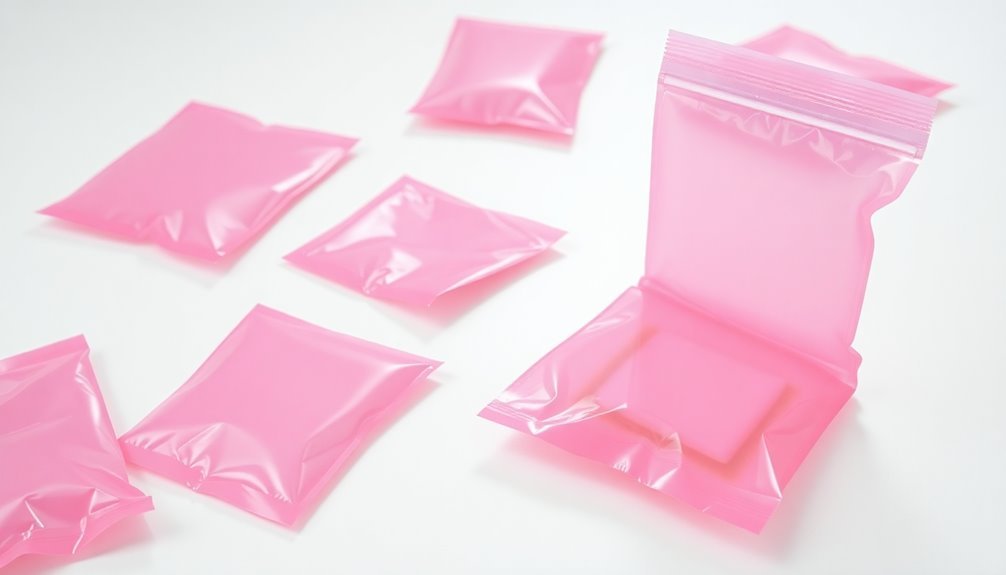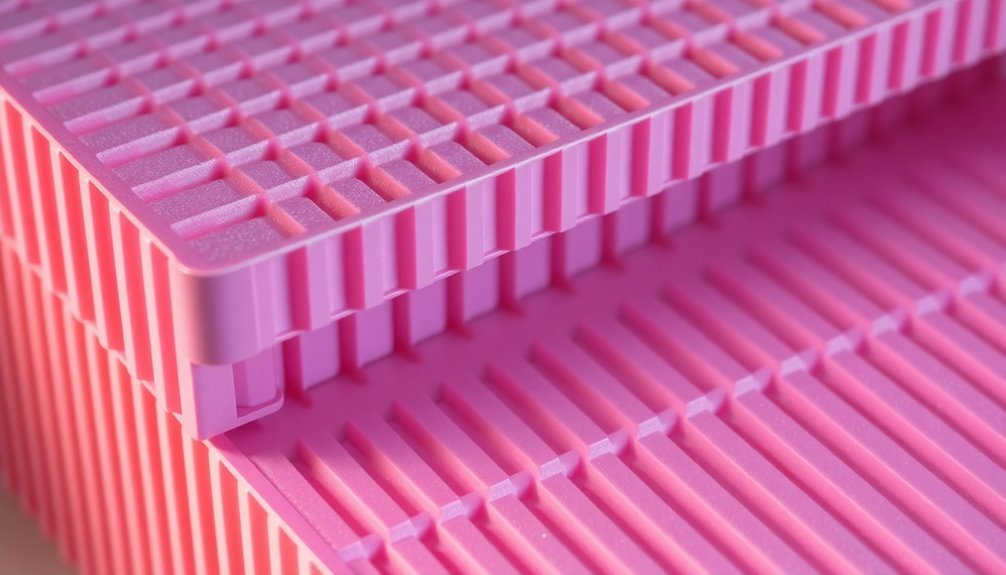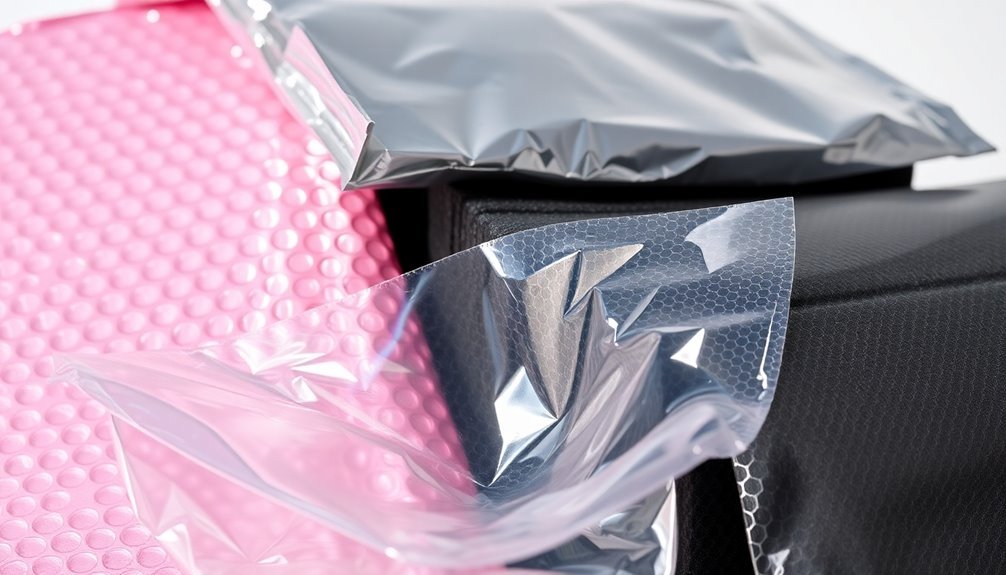When you're protecting sensitive electronics, you'll need reliable static-control packaging materials. Anti-static pink poly bags offer basic protection with their low surface resistivity and clarity for easy identification. Static dissipative foam materials provide cushioning while safely discharging static charges. Conductive carbon-loaded polyethylene containers guarantee static charges flow safely to ground, while multi-layer Faraday cage pouches deliver advanced shielding with superior tensile strength. Corrugated ESD plastic boxes round out your options with durable, waterproof protection and customizable dimensions. These proven solutions offer varying levels of protection to match your specific shipping needs.
Anti-Static Pink Poly Bags

Electronic manufacturers rely on anti-static pink poly bags as a cost-effective solution for protecting components from static damage. Made from low-density polyethylene with anti-static additives, these distinctive pink bags prevent static charge buildup while offering flexibility and customization options. Over 30 standard sizes are available to accommodate various packaging requirements.
You'll find them available in 2 mil and 4 mil thicknesses, providing both clarity and durability for your packaging needs.
These bags feature surface resistivity less than 1×10^12 ohms/sq, meeting critical industry standards like MIL-PRF-81705E and EIA-541. You can seal them through heat, tape, or ties, and their slight transparency allows you to identify contents easily.
They're particularly useful for non-critical applications within Electrostatic Protected Areas (EPAs).
When you're using these bags, you'll appreciate their amine-free composition, making them safe for polycarbonate boards. While they don't shield against external static fields, they're ideal for transporting non-ESD sensitive items.
To maintain their effectiveness, you'll want to store them in controlled environments and replace them regularly. They're manufactured using 100% renewable energy, and recyclable options are available if you're environmentally conscious.
Static Dissipative Foam Materials
A versatile solution in static-control packaging, static dissipative foam materials combine protective cushioning with controlled static discharge properties. They effectively balance conductivity and anti-static features, with a surface resistance ranging from 105 to 109 ohms.
They are specifically designed to dissipate static charges gradually, preventing sudden discharges that could damage sensitive electronic components.
When you're working with static dissipative foam, you'll notice it's typically manufactured using polyethylene foam enhanced with static dissipative additives. You can identify these materials by their characteristic black or pink coloring, which indicates their static control functionality. Quality checks should be routinely performed to maintain optimal protective performance.
The foam's base material may vary between PE, PU, EVA, or EPE foam, depending on your specific application needs.
You'll find static dissipative foam particularly useful for packaging and storing electronic components that require moderate static protection. It's an ideal choice when you need both cushioning and static control, as it can be customized into various forms like trays, inserts, and cushions.
Unlike conductive foam, you won't have to worry about rapid discharge, making it a cost-effective solution when full shielding isn't necessary.
Conductive Carbon-Loaded Polyethylene Containers

While static dissipative foam offers moderate protection, conductive carbon-loaded polyethylene containers provide superior ESD safeguards for highly sensitive components. These containers feature surface resistance between 10^3 and 10^5 ohms, creating an effective path for static charges to flow safely to ground.
You'll find they're manufactured with a 4 mil thickness, ensuring both durability and reliable conductivity. The material's corrosion resistant properties help protect sensitive components from environmental damage.
You can choose from various forms including bags, tubing, and roll stock sheeting, all of which meet MIL-PRF-81705D, Type II requirements. What makes these containers particularly effective is their Faraday Cage protection and humidity-independent performance. You won't need to worry about environmental conditions affecting their protective qualities.
When you're working in cleanroom environments, you'll appreciate that these containers don't shed particles. They're reusable without losing their ESD protection, making them cost-effective for long-term use. You can easily customize them to specific lengths and seal them to fit your product dimensions.
Whether you're storing, transporting, or handling sensitive electronic components, these containers maintain consistent protection against electrostatic discharge, ensuring your valuable components remain safe throughout their journey.
Multi-Layer Faraday Cage Pouches
Security reaches new heights with multi-layer Faraday cage pouches, which combine advanced shielding materials to create thorough protection for sensitive electronics.
These pouches don't just shield against electromagnetic threats – they're built for real-world durability. The heavy-gauge construction includes anti-static poly and bubble cushioning that absorbs shock, while water-resistant outer materials keep moisture at bay. The exceptional tensile strength of 11,500 PSI ensures these pouches maintain their integrity under stress.
You can use them to protect everything from laptops and tablets to night vision optics and key fobs.
To maintain effective protection, you'll need to properly seal the heat-sealable closure, ensuring the Faraday cage effect remains intact. The pouches feature removable padded walls and MOLLE webbing for customization, meeting both ANSI/ESD S20.20 and RoHS standards.
Whether you're storing devices in a data center or protecting equipment in the field, these pouches offer extensive protection that's both portable and reliable. Remember to inspect them regularly for wear that might compromise their shielding capabilities.
These pouches combine multiple layers of aluminum barrier shields and static-dissipative polyester working together to defend against electromagnetic interference and EMP threats, while providing over 50 dB of signal attenuation.
Corrugated ESD Plastic Boxes

Electronic components stay protected from electrostatic discharge thanks to corrugated ESD plastic boxes, which combine durable polypropylene construction with specialized static-preventing additives. You'll find these boxes available in various thicknesses from 3mm to 5mm, with customizable dimensions to suit your specific packaging needs. The boxes also effectively provide non-toxic packaging solutions for sensitive electronics.
| Feature | Benefit |
|---|---|
| Surface Resistivity | Protects components with 10^3-10^9 ohms range |
| Construction | Waterproof, shockproof corrugated plastic with carbon |
| Standards | Meets ANSI/ESD S20.20 and S541 requirements |
| Durability | Reusable and resistant to water and grease |
| Applications | Fits electronics, aerospace, and medical industries |
When you're handling sensitive electronic components, these boxes provide essential protection while offering cost-effective reusability. They're particularly valuable in electronics manufacturing, aerospace applications, and medical device shipping. You'll appreciate their versatility – they can be transformed into boxes, bins, dividers, and layer pads. Each box features clear traceability markings, including the ESD protective symbol and manufacturer's information, ensuring you're always compliant with industry standards. The boxes' eco-friendly PP material and proven performance in burst and edge crush tests make them a reliable choice for protecting your electronic components.
Frequently Asked Questions
How Long Can Static-Control Packaging Materials Remain Effective Before Needing Replacement?
You can expect your static-control packaging to last up to 5 years when stored in climate-controlled conditions. However, you'll need to perform annual audits and testing to guarantee it maintains effectiveness.
Can Static-Control Materials Be Safely Cleaned Without Damaging Their Protective Properties?
You can safely clean static-control materials using mild soaps and soft cloths. Don't use harsh chemicals or abrasive tools. Wipe gently and avoid excessive moisture to maintain the material's protective properties.
What Temperature Ranges Can These Packaging Materials Safely Withstand?
You'll typically find static-control packaging can safely operate between -40°C to 125°C for storage. Don't exceed 190°C, as that's the upper limit for most static shielding bags before they lose effectiveness.
Are Static-Control Packaging Materials Safe for Direct Food Contact Applications?
No, you shouldn't use static-control packaging for direct food contact. These materials aren't designed to meet food safety regulations and could lead to harmful chemical migration into your food, risking contamination and health issues.
How Can You Test if Static-Control Packaging Is Still Providing Adequate Protection?
You'll need to perform surface resistance, volume resistance, electrostatic decay, and static shielding tests under controlled conditions (12%±3%RH, 73±5°F) to verify your packaging still meets protective standards within specified limits.
In Summary
You'll protect your sensitive electronic components from damaging static discharge by choosing the right packaging materials. Whether you're using pink poly bags, dissipative foam, carbon-loaded containers, Faraday pouches, or ESD boxes, make sure you're following proper handling procedures. Don't risk costly damage – invest in quality static-control packaging that's appropriate for your specific electronic storage and shipping needs.





Leave a Reply